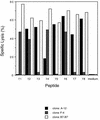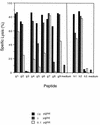Definition of amino acid residues on the epitope responsible for recognition by influenza A virus H1-specific, H2-specific, and H1- and H2-cross-reactive murine cytotoxic T-lymphocyte clones
- PMID: 9765498
- PMCID: PMC110370
- DOI: 10.1128/JVI.72.11.9404-9406.1998
Definition of amino acid residues on the epitope responsible for recognition by influenza A virus H1-specific, H2-specific, and H1- and H2-cross-reactive murine cytotoxic T-lymphocyte clones
Abstract
We defined the epitopes recognized by three influenza A virus-specific, H-2Kd-restricted CD8(+) cytotoxic T-lymphocyte (CTL) clones: H1-specific clone A-12, H2-specific clone F-4, and H1- and H2-cross-reactive clone B7-B7. The A-12 and B7-B7 clones recognized the same peptide, which comprises amino acids 533 to 541 (IYSTVASSL) of A/PR/8 hemagglutinin (HA). The F-4 and B7-B7 clones both recognized the peptide which comprise amino acids 529 to 537 (IYATVAGSL) of A/Jap HA. Amino acids 533 to 541 of A/PR/8 HA are compatible with amino acids 529 to 537 of A/Jap HA. Amino acid S at positions 3 and 7 was responsible for recognition by H1-specific clone A-12, while amino acid G at position 7 was responsible for recognition by H2-specific clone F-4. Two conserved amino acids, T at position 4 and A at position 6, were responsible for recognition by H1-, and H2-cross-reactive clone B7-B7. These results indicate that a single nine-amino-acid region is recognized by HA-specific CTL clones of three different subtype specificities and that the amino acids responsible for the recognition by the CTL clones are different.
Figures


Similar articles
-
Cytotoxic T lymphocytes recognize a cross-reactive epitope on the transmembrane region of influenza H1 and H2 hemagglutinins.Viral Immunol. 1989 Fall;2(3):163-73. doi: 10.1089/vim.1989.2.163. Viral Immunol. 1989. PMID: 2483503
-
Recognition of disparate HA and NS1 peptides by an H-2Kd-restricted, influenza specific CTL clone.Mol Immunol. 1991 Jan-Feb;28(1-2):1-7. doi: 10.1016/0161-5890(91)90080-4. Mol Immunol. 1991. PMID: 1707132
-
HA2 subunit of influenza A H1 and H2 subtype viruses induces a protective cross-reactive cytotoxic T lymphocyte response.J Immunol. 1988 Feb 15;140(4):1264-8. J Immunol. 1988. PMID: 2449498
-
Characterization of two distinct major histocompatibility complex class I Kk-restricted T-cell epitopes within the influenza A/PR/8/34 virus hemagglutinin.J Virol. 1991 Oct;65(10):5401-9. doi: 10.1128/JVI.65.10.5401-5409.1991. J Virol. 1991. PMID: 1716691 Free PMC article.
-
Overlapping cytotoxic T-lymphocyte and B-cell antigenic sites on the influenza virus H5 hemagglutinin.J Virol. 1990 Dec;64(12):6246-51. doi: 10.1128/JVI.64.12.6246-6251.1990. J Virol. 1990. PMID: 1700833 Free PMC article.
Cited by
-
The specificity of targeted vaccines for APC surface molecules influences the immune response phenotype.PLoS One. 2013 Nov 11;8(11):e80008. doi: 10.1371/journal.pone.0080008. eCollection 2013. PLoS One. 2013. PMID: 24244595 Free PMC article.
-
Mucosal CD8+ T cell responses induced by an MCMV based vaccine vector confer protection against influenza challenge.PLoS Pathog. 2019 Sep 16;15(9):e1008036. doi: 10.1371/journal.ppat.1008036. eCollection 2019 Sep. PLoS Pathog. 2019. PMID: 31525249 Free PMC article.
-
Preferential amplification of CD8 effector-T cells after transcutaneous application of an inactivated influenza vaccine: a randomized phase I trial.PLoS One. 2010 May 26;5(5):e10818. doi: 10.1371/journal.pone.0010818. PLoS One. 2010. PMID: 20520820 Free PMC article. Clinical Trial.
-
Chimeric hemagglutinin influenza virus vaccine constructs elicit broadly protective stalk-specific antibodies.J Virol. 2013 Jun;87(12):6542-50. doi: 10.1128/JVI.00641-13. Epub 2013 Apr 10. J Virol. 2013. PMID: 23576508 Free PMC article.
-
MCMV-based vaccine vectors expressing full-length viral proteins provide long-term humoral immune protection upon a single-shot vaccination.Cell Mol Immunol. 2022 Feb;19(2):234-244. doi: 10.1038/s41423-021-00814-5. Epub 2022 Jan 7. Cell Mol Immunol. 2022. PMID: 34992275 Free PMC article.
References
-
- Kuwano K, Tamura M, Ennis F A. Cross-reactive protection against influenza A infections by an NS1-specific CTL clone. Virology. 1990;178:174–179. - PubMed
-
- Kuwano K, Braciale T J, Ennis F A. Cytotoxic T lymphocytes recognize a cross-reactive epitope on the transmembrane region of influenza H1 and H2 hemagglutinins. Viral Immunol. 1989;3:163–173. - PubMed
-
- Kuwano K, Reyes V E, Humphreys R E, Ennis F A. Recognition of disparate HA and NS1 peptides by an H-2Kd-restricted influenza specific CTL clone. Mol Immunol. 1991;3:163–173. - PubMed
MeSH terms
Substances
LinkOut - more resources
Full Text Sources
Other Literature Sources
Molecular Biology Databases
Research Materials

